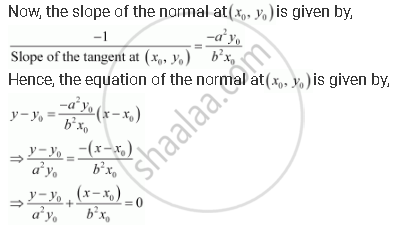Advertisements
Advertisements
Question
Find the equations of the tangent and normal to the hyperbola `x^2/a^2 - y^2/b^2` at the point `(x_0, y_0)`
Solution


APPEARS IN
RELATED QUESTIONS
Find the equations of the tangent and normal to the curve `x^2/a^2−y^2/b^2=1` at the point `(sqrt2a,b)` .
Find a point on the curve y = (x − 2)2 at which the tangent is parallel to the chord joining the points (2, 0) and (4, 4).
For the curve y = 4x3 − 2x5, find all the points at which the tangents passes through the origin.
Find the equations of the tangent and normal to the parabola y2 = 4ax at the point (at2, 2at).
Find the equation of the normal to curve y2 = 4x at the point (1, 2).
The slope of the tangent to the curve x = t2 + 3t – 8, y = 2t2 – 2t – 5 at the point (2,– 1) is
(A) `22/7`
(B) `6/7`
(C) `7/6`
(D) `(-6)/7`
Find the slope of the tangent and the normal to the following curve at the indicted point x = a (θ − sin θ), y = a(1 − cos θ) at θ = −π/2 ?
Find the slope of the tangent and the normal to the following curve at the indicted point x = a (θ − sin θ), y = a(1 − cos θ) at θ = π/2 ?
Find the slope of the tangent and the normal to the following curve at the indicted point x2 + 3y + y2 = 5 at (1, 1) ?
Find the points on the curve x2 + y2 = 13, the tangent at each one of which is parallel to the line 2x + 3y = 7 ?
Who that the tangents to the curve y = 7x3 + 11 at the points x = 2 and x = −2 are parallel ?
Find the equation of the tangent and the normal to the following curve at the indicated point y = x4 − 6x3 + 13x2 − 10x + 5 at x = 1?
Find the equation of the tangent to the curve x = θ + sin θ, y = 1 + cos θ at θ = π/4 ?
Find the equation of the tangent and the normal to the following curve at the indicated points x = at2, y = 2at at t = 1 ?
Find the equation of the normal to the curve ay2 = x3 at the point (am2, am3) ?
Find the equation of the tangent line to the curve y = x2 + 4x − 16 which is parallel to the line 3x − y + 1 = 0 ?
Find the equation of the tangents to the curve 3x2 – y2 = 8, which passes through the point (4/3, 0) ?
Find the angle of intersection of the following curve x2 + 4y2 = 8 and x2 − 2y2 = 2 ?
Find the angle of intersection of the following curve x2 = 27y and y2 = 8x ?
Show that the curves 2x = y2 and 2xy = k cut at right angles, if k2 = 8 ?
Prove that the curves xy = 4 and x2 + y2 = 8 touch each other ?
Show that the curves \[\frac{x^2}{a^2 + \lambda_1} + \frac{y^2}{b^2 + \lambda_1} = 1 \text { and } \frac{x^2}{a^2 + \lambda_2} + \frac{y^2}{b^2 + \lambda_2} = 1\] intersect at right angles ?
Write the angle made by the tangent to the curve x = et cos t, y = et sin t at \[t = \frac{\pi}{4}\] with the x-axis ?
Write the equation of the normal to the curve y = x + sin x cos x at \[x = \frac{\pi}{2}\] ?
Write the angle between the curves y = e−x and y = ex at their point of intersections ?
If the line y = x touches the curve y = x2 + bx + c at a point (1, 1) then _____________ .
Find the angle of intersection of the curves \[y^2 = 4ax \text { and } x^2 = 4by\] .
Find the equation of the tangent line to the curve `"y" = sqrt(5"x" -3) -5`, which is parallel to the line `4"x" - 2"y" + 5 = 0`.
Find an angle θ, 0 < θ < `pi/2`, which increases twice as fast as its sine.
Find the angle of intersection of the curves y = 4 – x2 and y = x2.
Find the equation of the normal lines to the curve 3x2 – y2 = 8 which are parallel to the line x + 3y = 4.
The points at which the tangents to the curve y = x3 – 12x + 18 are parallel to x-axis are ______.
The slope of tangent to the curve x = t2 + 3t – 8, y = 2t2 – 2t – 5 at the point (2, –1) is ______.
The tangent to the curve y = 2x2 - x + 1 is parallel to the line y = 3x + 9 at the point ____________.
The tangent to the curve y = x2 + 3x will pass through the point (0, -9) if it is drawn at the point ____________.
Find the points on the curve `y = x^3` at which the slope of the tangent is equal to the y-coordinate of the point
If m be the slope of a tangent to the curve e2y = 1 + 4x2, then ______.
If the tangent to the conic, y – 6 = x2 at (2, 10) touches the circle, x2 + y2 + 8x – 2y = k (for some fixed k) at a point (α, β); then (α, β) is ______.
